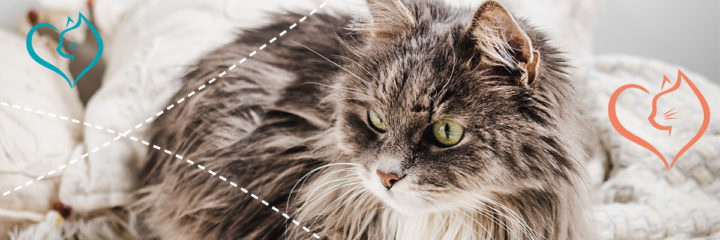
Summary
- According to Hurst & Shepard (1986), the emerging emotions in a crisis situation can go through seven phases and are called the rollercoaster of emotions
- The phases of shock, denial, anger, fear, depression and finally acceptance can also be transferred to chronic renal failureLoss of kidney function, which may be sudden (acute) or gradual (chronic), as in chronic kidney disease. Loss of kidney function leads to a reduced filtration capacity (glomerular filtration rate) and, thus, an inability to sufficiently filter out urinary substances such as uraemic toxins. Renal... in cats
- An active approach to feline chronic kidney disease helps to manage the different phases
A ROLLERCOASTER RIDE OF FEELINGS
The diagnosis of chronic kidney disease (CKD) often hits the owner like a blow. The diagnosis sounds terminal and therefore usually triggers intense emotions. On the one hand you don’t want to lose your beloved family member, but on the other hand you don’t want the cat to suffer either. How do you deal with such an emotional situation?
There is no universal answer. Every cat owner experiences and copes with this situation differently. If the cat owner perceives the CKD diagnosis as an emotional crisis, there are different phases of feelings and coping strategies that each person experiences and uses individually. It is certainly not possible to prevent emotions in a difficult situation. However, knowledge of the emotional phases can be helpful in mitigating the emotions that arise by making it transparent to the cat owner which phase he is currently in. Knowing that there are phases will probably be helpful in itself.
According to Hurst & Shepard (1986), the nascent emotions in a critical situation can go through seven phases and are called the rollercoaster of emotions. This roller coaster model applies to lovesickness as well as to grief over the loss of a loved one or the loss of one’s job. The emotional ride goes from shock, denial, anger, fear, depression to acceptance. If one relates the individual phases to the chronic kidney disease of the cat, the individual emotional phases can be as follows:
(1) In the first phase, the premonition is described in which the cat owner notices, for example, that his cat has changed: it appears less vital and sleeps a lot. It might be playing less than usual and showing less interest in interacting with its owner. The cat owner will realise that something has changed. His or her intuition is suspicious, and the cat owner therefore goes to his or her vet.
(2) Along with the diagnosis of CKD comes the phase of shock. His premonition was right – now the cat owner knows that his cat is seriously ill. This is his worst-case scenario: his cat will soon no longer be with him and he is already anticipating the approaching end of his beloved pet. The cat owner is afraid for the life of his cat. Now the cat owner needs time to cope with this situation.
(3) Some cat owners feel the impending loss of their cat very vividly and will start to mourn. For the cat itself, but also for the loss of the daily common routines and the loved interaction with their pet. They grieve that living together with their cat will no longer be the same as it was before.
(4) In the subsequent phase of denial, the unwillingness to accept the CKD diagnosis, the reluctance to accept the disease and thus the whole situation itself, arises. This can be visible in statements such as: “My cat cannot be sick”. “The vet must be wrong.” This phase can also be accompanied by paralysis and inactivity, which is also characterised by a feeling of powerlessness and loss of control. The cat owner’s worries about his cat, but also about the imminent time and financial demands that CKD disease brings with it, interfere with this phase.

Anger, depression and/or feelings of guilt overwhelm the cat owner in this phase: “Why is this happening to my cat? “Where haven’t I been paying attention?” “Why didn’t I notice something before?” “If only I had visited the vet earlier!”. The cat owner is overwhelmed by his emotions and feels powerless faced with the diagnosis of CKD of his beloved cat. However, cat owners can also direct anger against others at this stage. For example, they may accuse them of being responsible for their cat’s situation or, in the case of a vet, of not “saving” their beloved cat. Anger can help the cat owner to distract himself from this pain. Suppressing anger can lead to depression (with feelings of hopelessness and laziness) or aggression towards others such as benamed vet.
The cat owner may also feel guilty if he thinks he cannot take sufficient care of his CKD-suffering cat. This includes his time and financial situation, but also his ability to care for the cat “professionally” (see blog article When caring makes you shrivel). CKD-sick cats often eat poorly and this can lead to feelings of guilt on the part of the cat owner if he or she feels responsible, e.g. for changing to dietary food. The cat owner may also feel guilty if he exposes his sick cat to the stressful aspects of vet visits (putting the cat in the transport box, long car rides, etc.) and treatments (such as taking blood samples).
(5) In the fifth phase, hope arises and the sixth and seventh phases are also marked by overcoming and accepting the crisis. If we relate these phases to the situation of the chronic kidney dieseas in cats, this can mean that the cat owner becomes active and informs himself extensively about the CKD and the stage of his cat. In doing so, they can seek help from outside (vet, forums, exchanges with other affected cat owners) and support from friends and acquaintances. An affected cat owner can also become an “expert” on his cat’s CKD disease by spending a lot of time reading and researching to understand the disease himself. The cat owner may find that the cat still has a few more years of good quality life ahead of it. And also that the time and money spent caring for the chronid diseased cat is feasible, plannable and can be integrated into their daily routine.
Surge of emotions
In addition to this, there are many other crisis models (e.g. by Johann Cullberg [1978] and the psychologist Vera Kast [2013, 2014, 2015]), which are usually presented in four phases. Phases can be named differently (e.g. phase of reaction, phase of processing) and described differently in terms of content than in the above-mentioned seven-phase roller coaster model. Common to all models is that the phases are not always run through in a consecutive manner. Phases can overlap or be repeated. The chronological progression is also very individual. While one cat owner is already managing his or her cat’s CKD properly, the other is still struggling with his or her emotions. The cat owner’s individual experience and the information available to them can help them to manage the crisis. This is what led me to create this CKD website cat.life.
I am writing particularly for affected cat owners, because for me, from my own experience, suppression was not a solution and, in case of doubt, valuable time is lost. Strong emotions are present and it is difficult to suppress them. But becoming active and consciously dealing with the seemingly hopeless situation of my cat has helped me a lot to use the remaining time with her and to recognise it as valuable. In addition, my acceptance of the situation has helped me to see room for action again and not feel so helpless and vulnerable. It was then that I began to gather all the information about chronic kidney disease that was important to me. After I was also able to help friends and relatives with my gathered information, the idea for this website was finally born. That was already some years ago. Therefore, I use this blog to discuss more recent and interesting topics and facts.
For more information about caregiver burden, read my latest blog article:
Bibliography:
- Hurst, J.B. / Shepard, J. W. (1986): The Dynamics of the Plant Closing: An Extended Emotional Roller Coaster Ride, Journal of Counseling & Development, 64(6), S. 401–405.
- Cullberg, J. (1978): Krisen und Krisentherapie. Psychiatrische Praxis (5). Gießen: Psychosozial.
- Kast, V. (2013): Der schöpferische Sprung. Vom therapeutischen Umgang mit Krisen. Ostfildern: Patmos.
- Kast, V. (2014): Lebenskrisen werden Lebenschancen. Wendepunkte des Lebens aktiv gestalten. Freiburg im Breisgau: Herder.
- Kast, V. (2015). Zäsuren und Krisen im Lebenslauf. Wien: Picus.



